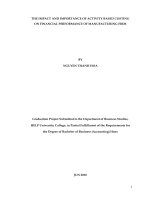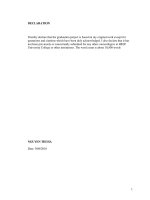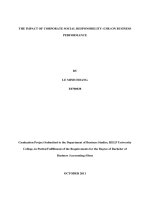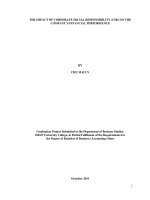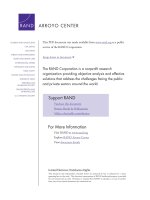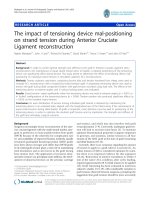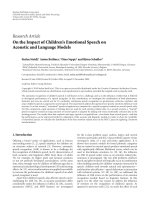the impact of abc (activity based costing) on manufacturing firm performance in vietnam
Bạn đang xem bản rút gọn của tài liệu. Xem và tải ngay bản đầy đủ của tài liệu tại đây (578.53 KB, 76 trang )
DECLARATION
I hereby declare that the graduation project is based on my original work except for
quotations and citations which have been duly acknowledged. I also declare that it has
not been previously or concurrently submitted for any other course/degree at HELP
University College or other institutions. The word count is about 10,500 words
NGUYEN THI HA
Date: 30/6/2010
1
ACKNOWLEDGEMENTS
Firstly, I want to send my thankfulness to my advisor Dr. Le Van Lien for his
continuous support in my thesis. The advices of Dr. Lien helped me so much in the
accurate thesis structure, also the method to simplify the result. He taught me as how to
offer the right questions and express my ideas. I also want to send my thankfulness to
Ms Sumathi who guided me how to use the statistic method, step by step to do this
research enthusiastically.
Secondly, I want to thank to the sources such as a large amount of manufacturing
firms that provide a lots of necessary information from responding mail to me. The data
is really significant for my result finding, integrated with some statistic methods, from
that I could offer my conclusion effectively.
Thirdly, I also want to thank to the internet sources such as prior researches that
really helped me in how to find the result, hypothesis setting, questionnaires making. I
also want to thank to the sources, other researchers that provide the conceptual theories
that contributed to my literature review chapter.
In finally, I want to send my thankfulness to my friends, my family who has
supported, encouraged and motivated me in doing this thesis.
2
THE IMPACT OF ABC (ACTIVITY BASED COSTING)
ON MANUFACTURING FIRM PERFORMANCE IN VIETNAM
BY
NGUYEN THI HA
June 2010
Supervisor: Dr. Le Van Lien
Abstract
In this study, Based on the data from a large sample amount of Vietnam manufacturing
plants and some research models, I want to demonstrate the impact of Activity-based
costing (ABC) on manufacturing performance, especially is the plant performance
regarded as operational performance rather than financial performance, is directly by the
World-class manufacturing (WCM) practices adoption. From the result of sample
research, I can conclude that ABC has no significant or very little direct effect on
performance of plant that is represented by the improvement of manufacturing cost,
cycle time and the quality of product. However, WCM present as a mediator that helps
to explore the impact of ABC on plant performance clearly. By using results and
methods of many other researchers, I evaluate the relationship between ABC
implementation, WCM adoption and plant performance. From this evaluation, I can see
that ABC can’t improve performance of plant by itself, and one of the ways to see
overall impact of ABC is the implementation of WCM.
3
TABLE OF CONTENTS
Page
Declaration of Originality and word count
i
Acknowledgements
ii
Abstract
iii
Table of Content
iv
List of Figures
vii
List of Tables
viii
List of Abbreviations
ix
Chapter I INTRODUCTION
1.1 Introduction
2
1.2 Need for Research
4
1.3 Elements of the Research
4
1.3.1 Research Question
4
1.3.2 Research Objective
4
1.4 Scope of Research
5
1.5 Assumptions
6
1.6 Plan of Presentation
6
Chapter II LITERATURE REVIEW
2.1 A General Look at ABC
8
2.1.1 The conceptualization of ABC
12
2.1.2 The importance of ABC
14
2.2 The ABC criticism
16
4
2.3 The fundamental of World-Class Manufacturing (WCM) practices
17
2.4 The relationship and the impact of ABC implementation & WCM practices
18
on plant performance
Chapter III RESEARCH METHODOLOGY
3.1 Research objective
21
3.2 Research strategy
21
3.3 Research hypothesis
22
3.3.1 Impact of Activity-based Costing on World-class Manufacturing
23
3.3.2 Impact of World-class Manufacturing on Plant Performance
26
3.3.3 Impact of ABC on Plant Performance: A Mediation Mechanism
28
3.4 Measurement of variables
30
3.4.1 Dependent variables (Plant performance)
30
3.4.2 Independent variables
31
3.4.2.1 Activity Based Costing (ABC) implementation
31
3.4.2.2 World-Class Manufacturing practices (WCM) implementation
35
3.4.2.3 Plant-level control variables
35
3.5 Research methodology
36
3.6 Data sources and sampling
37
3.6.1 Sample selection
37
3.6.2 Data collection method
37
3.7 Limitation of research
38
Chapter IV ANALYSIS
4.1 Results Analysis
41
5
4.1.1 Percentage method
41
4.1.2 Results analysis for Hypothesis 1 to 3
46
4.1.2.1 Impact of Activity-based Costing on World-class Manufacturing
46
4.1.2.2 Impact of World-class Manufacturing on Plant Performance
47
4.1.2.3 Impact of ABC on Plant Performance: A Mediation
50
4.2 Discussion
Mechanism
51
Chapter V CONCLUSION
5.1 Implication of research
53
5.2 Conclusion
53
References
55
Appendixes
63
6
LIST OF FIGURES
Figure
Title
Chapter 1
N/A
N/A
Chapter 2
Figure 2.1
Figure 2.2
Page
The Estimation of Activity Based Costing (ABC)
The proportion of material, direct labor and overhead costs in
today’s world
The proportion of material, direct labor and overhead costs where
traditional cost systems focus their attention
12
15
Chapter 3
Figure 3.1
Conceptual research model
23
Chapter 4
N/A
N/A
Chapter 5
N/A
N/A
Figure 2.3
15
7
LIST OF TABLES
Table
Title
Page
Chapter 1
N/A
N/A
Chapter 2
Table 2.1
The Changes in Manufacturing Environment
14
Chapter 3
Table 3.1
Questionnaires’ result
32
Chapter 4
Table 4.1
Table 4.2
Table 4.3
Table 4.4
The impact of ABC (percentage based)
The descriptive statistic result
The WCM implementation
Impact of WCM and ABC on Plant Performance
42
45
46
49
Chapter 5
N/A
N/A
8
LIST OF ABBREVIATIONS
Abbreviation
Full Name
VBC
Volume Based Costing
ABC
Activities Based Costing
WCM
World-class Manufacturing Practices
TQM
Total Quality Management
JIT
Just-in-time Manufacturing
AMP
Advanced Manufacturing Practices
9
CHAPTER I: INTRODUCTION
1.1 Introduction
1.2 Need for Research
1.3 Elements of the Research
1.4 Scope of Research
1.5 Assumptions
1.6 Plan of Presentation
10
1.1 Introduction
Along with the development of market economy, accounting information requires
precise, more detailed and updated. Previously, manufacturing companies only use
traditional cost allocation methods as VBC (Volume Based Costing) but until now, this
allocation method is gradually being replaced by activity based costing method ABC
(Activities Based Costing). The reason is that in according to the VBC method, the
distribution of overall production costs in manufacturing costs - cost factories are
usually allocated to each product based on a fixed allocation criteria (usually direct labor
hours). The allocation of all common expenses according to such fixed criteria is
unsuitable because general expenses include many items that have different nature in the
production process makes the actual cost of the product reflected not accurately lead to
the false business decisions making. But according to the ABC method, common
expenses are allocated based on cost’s factors so we can see that ABC method can
provides accurate cost information and a more sensible approach than the traditional cost
accounting. In according to Cooper and Kaplan, accurate cost data is provided by ABC
adoption that is useful in the strategic decisions making of business process
performance. This accurate cost data also useful in product mix, sourcing, pricing,
process improvement, and evaluation processes (Cooper and Kaplan, 1992; Swenson,
1995).
This paper examines the impact of ABC on plant level operational. Using the Vietnam
manufacturing plants sample, we find that ABC use is indirectly impact on
manufacturing
performance
through
the
advanced
manufacturing
practice
implementation. Based on the paper the Association between Activity-Based Costing
11
and Manufacturing Performance in the Journal of Accounting Research Vol. 40 No. 3
June 2002 Printed in U.S.A is written by Christopher D. Ittner, William N. Lanen and
David F. that said: Plants with higher quality levels and better cycle time improvements
will be associated more with extensive use of ABC, although there is not association of
ABC with the reduction of manufacturing cost but the association can be directly
occurred by the improvement of quality and cycle time. In addition, in the financial
performance, there is no association between ABC use and return on assets.
Furthermore, the finding showed that there is a little evidence that the operational
characteristics of plant are important factors that will be contingent with the association
of ABC use and accounting profitability. That reading also showed that from the ROA
results, we can see the association between ABC use and net financial benefits is varies
with the characteristics of plant’s operational. Especially, ABC may be more beneficial
for performance if it adopts and implements advanced manufacturing practices (Shields
and Young [1989], Kaplan [1992], Cooper [1994]). Base on that point, perceptual
measures of ABC success is used by prior studies such as find whether the relationship
between the adoption of advanced manufacturing practices and the success of ABC
implementation is positive (see Anderson and Young [1999] for a review).
Because ABC has a little direct impact on plant manufacturing performance, base on
prior research’s analysis methods, I do a research in a cross-sectional sample of Vietnam
manufacturing firms to survey the indirect impact of ABC on manufacturing
performance through the adopt of WCM practices .
12
1.2 Need for research
Today, the competitive world of business is so high, with using ABC method in
manufacturing performance, many firms have provided accurate information that is to
determine the optimal product mix so that management can make better decisions and
the result is to have company’s effectiveness. However, in fact, in Vietnam, not all firms
success with this method. The reason why is that businesses do not want to renew
method and try to get the traditional cost accounting, or do not want to change because
they have no understanding of this new method, but the main reason is that the lack of
advanced manufacturing practice. This research’s purpose is to provide the better
information to managers that can help them to understand the overall the positive
indirect impact of ABC on manufacturing plant performance through the WCM
practices implementation.
1.3 Elements of the research
1.3.1 Research question
What is the overall direct and indirect impact of ABC on manufacturing firm
performance? And can WCM mediate the impact of ABC on plant performance by the
performance improvement?
1.3.2 Research objective
Prior studies have almost concentrates on the direct impact of ABC and almost them,
they has only little care about how to increase other organizational capabilities by
indirect impact of ABC implementation. Prior researcher showed the ABC
implementation’s benefits (Foster and Swenson, 1997; Ittner and Larcker, 2001), in
13
evaluating the successful outcomes and the plant performance measures, one of them
have explored the research. Moreover, ABC success’s definition has often been
regarded as “benefits of financial”, “ABC satisfaction”, or “decision making by the use
of ABC.” From these definition and the sources of methodology, I bring out the
measure approach that is needed evaluate the impact of ABC. Beside of firm-level
financial metrics focus, It is also significant to concentrate on the measurement of
process-level performance, since before firm’s aggregate performance reflect ABC
implementation, the potential impact may be appropriated.
In this thesis, I mainly concentrate in the point that will show the ABC’s impact on
plant performance through the enabler of organizational capacity. Particularly, in this
research, the positive relationship between implementation of ABC and WCM
practices and the impact of them on plant-level operational performance will be
investigated.
1.4 Scope of research
In this research, I will develop framework which indicates the WCM capacity
enablement will be mediated factor to show the ABC adoption impact on plant
performance is positive. Since ABC is adopted at the business process level, I
concentrate mainly on the measure of operational process performance and the
manufacturing plant is treated as a unit of analysis. In addition, prior studies showed the
of ABC’s impact traditionally so the revision and validation of those prior studies are
needed by using many types of model and approaches. In difference with Ittner et al.
(2002) my result is that, on plant performance, ABC has a statistically indirect impact
14
that is showed by the mediation, advanced manufacturing capabilities is represented as
WCM.
1.5 Assumptions
I suppose that ABC implementation by itself is unable to provide the direct valuable
impactions, but will be enable to create the convenient condition for the advanced
manufacturing practices implementation and other capabilities, as the result, this
capacities may contribute into plant performance improvements. Previous studies that
have tried to explored the direct impact of ABC but almost, they have to conclude that
the organization needs the improvement.
1.6 Plan of presentation
My research is organized in five chapters. In chapter II, the literature will be reviewed
on the fundamental of ABC, the conceptualization of ABC, advanced manufacturing
practices, their relationship and their impact in according to the prior research. Then, in
chapter III, I present methodology that shows the description of my research data,
hypothesis, variables’ measurement and limitations. Next, in chapter IV, I analyze
results of the statistical estimation, and a discussion. Finally, in chapter V, I summarize
my findings and the study implications for future research.
15
CHAPTER II: LITERATURE REVIEW
2.1 A General Look at ABC
2.2 The ABC criticism
2.3 The fundamental of World-Class Manufacturing (WCM) practices
2.4 The relationship and the impact of ABC implementation & WCM practices on plant
performance
16
2.1 A general look at ABC
ABC is method that replaced traditional costing method. Previous period, everybody still
think that customers purchase a large volume of products, the loyal customers will bring
the high profitability. The customer profitability researches disclosed that those above
judges are not really correct. ABC method determines all activities expenses, then
delivery those expenses in according to products and services base on activity amount or
occurred transactions in the providing process of products or services. Hence, ABC
method can help managers to have the optimal investment value of shareholders and
increase the effectiveness of company’s activities.
The costing methods based on counting on indirect expenses. The benefits of ABC
method can be mentioned as: Determine customers, products, delivery channel that
create the most profit and least profit. Determine factors that make increase or decrease
financial activity’s efficiency. Forecast exactly the original causes of the financial
activity’s bad effectiveness. Keep track of activity expenses and operational processes.
Equip for managers reporting data of the valuable expenses for operational
improvement. Support management and adjust marketing combination. Increase the
ability of customer negotiating. Locate products better.
With ABC method, the service expenses can be determined definitely. After minus the
product expenses and services expenses for each customer, the customer profitability
will be calculated. The ABC method calculates customer expenses and help to locate
correlative products or services. In addition, ABC application can help staff to grasp all
related expenses, help them to analyze the expenses and specify the plus value and no
17
plus value activities, from that, improve effectively activities. This is a complete process
continuously starting from the cost analysis, to reduce the activities that do not create
added value and thus achieve the overall performance effectiveness. Moreover, ABC
also helps companies create better products that meet the needs of the market with a cost
competitive. Analysis of profitability by product and customer profitability, this
approach has contributed positively to the decision making process of grant
management; company can improve efficiency and reduce operating costs without
sacrifice to bring value to customers. Many companies also use the ABC method in the
implementation of the card balance (balanced scorecard). ABC method helps companies
model the impact of cost cutting and cost control savings. Overall, ABC is a dynamic
method to promote continual improvement. With ABC, any company can create
competitive advantage on costs and continuously create value for shareholders and
customers.
In addition, also talk about the benefits of ABC, prior studies found and affirmed that:
ABC is defined as a separately task that can help to ensure the product or service
delivering, cost drivers using and assign the cost of activity to products or services that
relate to these activities (Cooper, 1988; Ittner et al. 2002). Base on direct labor, machine
hours, traditional costing system use them to allocate expenses that combined with the
indirect activity to product and services. However, ABC distinguishes the indirect
expenses and resources supporting by activities, and to assign the expense, the drivers of
those activities are important factor (Cooper and Kaplan, 1991). Hence, a more
structured approach of ABC adoption result provide to plant mangers for expenses
evaluating that is associated with particular activities used in product supporting.
18
From the prior research, they affirmed that the impact of ABC has produced a lot of
evidences. Firstly, ABC is argued as to help economics capturing of production process
that is more accurately than traditional costing system, and accurate costing data also has
provide more (Cooper and Kaplan, 1991; Ittner, 1999). Secondly, prior research also
said that the implementation of ABC brings out more benefits for organization’s
operation. (Anderson and Young, 1999; Cooper and Kaplan, 1991). In addition to,
researchers also showed that the benefits achieved of ABC implementation are from the
improvement of production processes, causal cost driver, the better product
development’s information, sourcing, product mix and other strategic decisions
(Anderson, 1995; Shields, 1995).
As refer to the benefits of ABC implementation, literature showed three potential types
of benefit that help to improve operational performance: cost lowering, quality
improvement, and manufacturing cycle time reducing (e.g., Anderson and Young
[1999]; Ostrenga et al. [1992]). In addition to, in refer to the cost associated with the
value-added and non value-added activities, ABC advocates (e.g., Cooper and Kaplan
[1991, chapter 5]; Ostrenga et al. [1992]; Carolfi [1996]) showed that detailed
information on the drivers of activity costs is provided by activity-based costing
systems. This information help managers in costs reducing by designing products and
processes that consume fewer activity resources that can also increase the efficiency of
existing activities, the non valued added activities id eliminated to customers, and from
that, the coordination of customers and suppliers is improved.
19
In relation to the similar conclusion about the benefit of ABC in cost reducing to non
value added activities, Carolfi also said that since ABC provide better business processes
visibility and the cost drivers, it might help managers to reduce and eliminate cost of
activities that related to non value added and from that, the efficiencies of existing
process are improved (Carolfi, 1996). Moreover, from the information visibility
improvement, it may also support the quality-related initiatives deployment by realize
the activities that combined with poor product quality, and their cost drivers (Ittner,
1999, Cooper et al. 1992). Hence, prior researchers suggest that in the activities process
improvement such as total quality management (TQM) programs, ABC adoption will
have the valuable association (Ittner and Larcker, 1997a, 1997b; Anderson, Hesford, and
Young, 2002).
20
2.1.1 The conceptualization of ABC
ABC is a two-stage procedure: Activity -> Activities’ costs -> Products or services.
This process is disclosed more clearly in figure 2.1
Figure 2.1: the estimation of ABC
Firstly, research activities create costs in each cost center; make a list of different
activities. Then, in each cost center, it will be allocated to each activity that is directly
related to activities are allocated. Secondly, in each type of activity, we should
determine standards that measure the change of expenses using degree. These
standards are considered as the cost allocation base for each type of product, service
or subject costs. The standards are used to allocate are: a direct hours number of
workers, wages of direct workers, the number of orders, number of units transported.
21
Thirdly, the similar distribution standard activities have to gather into a “sub-center”.
Depending on the product’s technical nature, services or objects continue to bear the
costs that break down into small groups to calculate cost.
Thus, we can say that the ABC method can make an indirect cost as a direct cost
with an object creates definite costs. The selection of activities and cost allocation
standard reasonably help managers have more reliable reports of products’ cost and
services’ cost with higher reliability than traditional methods compare to tradition
based costing method.
In short, the ABC method improved operating systems by determining the cost of a
business. This cost determining method change the basis to allocate the cost centre
for products. Or we can say that instead of expenses allocation according to direct
labor, they are allocated according to the cause of the factors used for the product or
work requirements. In addition, this determination method change many types of
general production costs in that these costs are considered indirect in nature but has
been associated with particular activities and thus are directly calculated to each
product. However, the ABC method is complicated and takes more effort than
traditional methods. But, with the scientific development of information technology
today has reduced much time and effort for the application of this method. Thus, the
method of accounting based on operating costs would be indispensable to the
application of corporate governance.
22
2.1.2 The importance of ABC
In according to Sullivan, the lists of the new manufacturing environment’s
characteristics is shown in table 2.1,
Table 2.1: The changes in manufacturing environment (Sullivan, William G., 1992)
Yesterday
New Paradigm
High volume, long production runs,
Low volume, short product runs, short
long product life cycles
product life cycles
Small number of product variations in a
Domestic market
an international market
Large direct labor component; high cost
of processing information
Small
indirect/overhead
relation to direct labor
Large number of product variations in
Relatively
high
technology
costs;
relatively low information processing costs
costs
in
Large
indirect/overhead
costs
in
relation to direct labor
In competitive world, manufacturing companies change more and more, and more
information required, highly flexible, and have to respond to the customer expectations
immediately (Sullivan, William G., 1992). Traditional cost accounting is rapidly
disappearing because of the change of manufacturing environment. The development of
traditional accounting systems is suitable when direct labor has high percentage of total
product costs.
The technologies of manufacturing are changing, such as the just-in-time philosophy,
robotics, and flexible manufacturing systems that decreased the favor of the component
23
of direct labor of production and make the increase in overhead costs. Nowadays, in the
recent manufacturing environment, 10% of the costs are accounted for direct labor,
55% are accounted for material for and overhead is 35% (See Figure 2.2 and 2.3)
Figure 2.2: The proportion of material, direct labor and overhead costs in today’s
world
Overhead, 35%
Materials
Direct Labor
Materials, 55%
Overhead
Direct Labor, 10%
Figure 2.3: The proportion of material, direct labor and overhead costs where
traditional cost systems focus their attention.
Overhead, 15%
Materials, 10%
Materials
Direct Labor
Overhead
Direct Labor, 75%
As a result, product cost will be distorted if we use traditional based costing method,
the reason is the allocation of overhead costs to the products based on each product’s
direct labor hours used (Harsh, Mary Frances., 1993, Liggett, H. R., J. Trevino, and
24
J. P. Lavelle ., 1992). Several situations that Cooper report can lead to occurrence of
distortion, they include: the diversity of production volume, complexity, material and
setup (Cooper, Robin .,1988).
The cost distortion can be solve by the using of ABC method that provides
information to identify the overhead’s component precisely such as better grounded
product design, development, production, and distribution decisions. The resource
costs that ABC help to assign to products is more accurately and the it also the main
tool that serve for companies’ decision support. (Harsh, Mary Frances., 1993,
Johnson, H. T. and Robert S. Kaplan., 1987). In according to Ioannou and Sullivan
who also affirm that the ABC can make better decision making in manufacturing firm
by offer the best obtained information. (Ioannou, George and William G. Sullivan.,
1999).
2.2 The ABC criticism
In contrast to the ABC adoption benefits, Datar and Gupta (1994) claimed that the rise
of number of cost pools and the cost bases specification improvement may lead to the
increase of errors in product cost measurement. Banker and Potter (1993) and
Christensen and Demski (1997) said that the ability of cost estimation of ABC belong to
some other factors that include the market competitiveness, the information technology
infrastructure quality. Noreen (1991) also suggests that ABC implementation can only
provide benefit under specific conditions. Since, the mix result of ABC benefits has
produced by empirical studies that have analyzed the ABC’s impact on firm
performance (Itnner and Larcker, 2001; Gordon and Silvester, 1999). In addition to,
25
